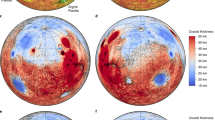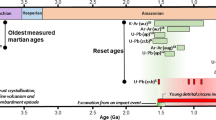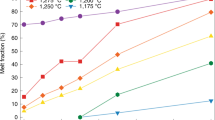Abstract
The most prominent feature on the surface of Mars is the near-hemispheric dichotomy between the southern highlands and northern lowlands. The root of this dichotomy is a change in crustal thickness along an apparently irregular boundary, which can be traced around the planet, except where it is presumably buried beneath the Tharsis volcanic rise1,2. The isostatic compensation of these distinct provinces2,3 and the ancient population of impact craters buried beneath the young lowlands surface4 suggest that the dichotomy is one of the most ancient features on the planet3. However, the origin of this dichotomy has remained uncertain, with little evidence to distinguish between the suggested causes: a giant impact5,6 or mantle convection/overturn7,8,9. Here we use the gravity10 and topography11 of Mars to constrain the location of the dichotomy boundary beneath Tharsis, taking advantage of the different modes of compensation for Tharsis and the dichotomy to separate their effects. We find that the dichotomy boundary along its entire path around the planet is accurately fitted by an ellipse measuring approximately 10,600 by 8,500 km, centred at 67° N, 208° E. We suggest that the elliptical nature of the crustal dichotomy is most simply explained by a giant impact, representing the largest such structure thus far identified in the Solar System.
This is a preview of subscription content, access via your institution
Access options
Subscribe to this journal
Receive 51 print issues and online access
$199.00 per year
only $3.90 per issue
Buy this article
- Purchase on Springer Link
- Instant access to full article PDF
Prices may be subject to local taxes which are calculated during checkout




Similar content being viewed by others
References
Zuber, M. T. et al. Internal structure and early thermal evolution of Mars from Mars Global Surveyor topography and gravity. Science 287, 1788–1793 (2000)
Neumann, G. A., Lemoine, F. G., Smith, D. E. & Zuber, M. T. Marscrust3: A crustal thickness inversion from recent MRO gravity solutions. Lunar Planet. Sci. Conf. 39, abstr. 2167 (2008)
Solomon, S. C. et al. New perspectives on ancient Mars. Science 307, 1214–1220 (2005)
Frey, H. V., Roark, J. H., Shockey, K. M., Frey, E. L. & Sakimoto, S. E. H. Ancient lowlands on Mars. Geophys. Res. Lett. 29 10.1029/2001GL013832 (2002)
Wilhelms, D. E. & Squyres, S. W. The martian hemispheric dichotomy may be due to a giant impact. Nature 309, 138–140 (1984)
Frey, H. & Shultz, R. A. Large impact basins and the mega-impact origin for the crustal dichotomy on Mars. Geophys. Res. Lett. 15, 229–232 (1988)
Zhong, S. & Zuber, M. T. Degree-1 mantle convection and the crustal dichotomy on Mars. Earth Planet. Sci. Lett. 189, 75–84 (2001)
Roberts, J. H. & Zhong, S. Degree-1 convection in the martian mantle and the origin of the hemispheric dichotomy. J. Geophys. Res. 111 E06013 10.1029/2005JE002668 (2006)
Elkins-Tanton, L. T., Hess, P. C. & Parmentier, E. M. Possible formation of ancient crust on Mars through magma ocean processes. J. Geophys. Res. 110 E12S01 10.1029/2005JE002480 (2005)
Konopliv, A. S. et al. MROMGM23C gravity model. NASA Planet. Data Sys. 〈http://pds.jpl.nasa.gov〉 (submitted)
Smith, D. E. et al. Mars Orbiter Laser Altimeter: Experiment summary after the first year of global mapping of Mars. J. Geophys. Res. 106 (E10). 23689–23722 (2001)
McGill, G. E. & Squyres, S. W. Origin of the martian crustal dichotomy: Evaluating hypotheses. Icarus 93, 386–393 (1991)
Phillips, R. J. et al. Ancient geodynamics and global-scale hydrology on Mars. Science 291, 2587–2591 (2001)
Banerdt, W. B. & Golombek, M. P. Tectonics of the Tharsis region of Mars: Insights from MGS topography and gravity. Lunar Planet. Sci. Conf. 31, abstr. 2038 (2000)
Andrews-Hanna, J. C., Zuber, M. T. & Hauck, S. A. Strike-slip faults on Mars: Observations and implications for global tectonics and geodynamics. J. Geophys. Res. 10.1029/2008JE002980 (in the press)
Arkami-Hamed, J. A coherent model of the crustal magnetic field of Mars. J. Geophys. Res. 109 E09005 10.1029/2004JE002265 (2004)
Smrekar, S. E., McGill, G. E., Raymond, A. & Dimitriou, A. M. Geologic evolution of the martian dichotomy in the Ismenius area of Mars and implications for plains magnetization. J. Geophys. Res. 109 E11002 10.1029/2004JE002260 (2004)
Harder, H. & Christensen, U. A one-plume model of martian mantle convection. Nature 380, 507–509 (1996)
Melosh, H. J. Impact Cratering: A Geologic Process (Oxford Univ. Press, New York, 1989)
Melosh, H. J. & McKinnon, W. B. The mechanics of ringed basin formation. Geophys. Res. Lett. 5, 985–988 (1978)
Kiefer, W. S. Gravity, topography, and tectonic segmentation of the martian hemispheric dichotomy: Evidence for multiple formation mechanisms. Lunar Planet. Sci. Conf. 38, abstr. 1470 (2007)
Strom, R. et al. Tectonism and volcanism on Mercury. J. Geophys. Res. 80, 2478–2507 (1975)
Tonks, W. B. & Melosh, H. J. Magma ocean formation due to giant impacts. J. Geophys. Res. 98, 5319–5333 (1993)
Marinova, M. M., Aharonson, O. & Asphaug, E. Mega-impact formation of the Mars hemispheric dichotomy. Nature 10.1038/nature07070 (this issue)
Nimmo, F. & Stevenson, D. J. Estimates of martian crustal thickness from viscous relaxation of topography. J. Geophys. Res. 106, 5085–5098 (2001)
Parmentier, E. M. & Zuber, M. T. Early evolution of Mars with mantle compositional stratification or hydrothermal crustal cooling. J. Geophys. Res. 112 E02007 10.1029/2005JE002626 (2007)
Mohit, P. S. & Phillips, R. J. Viscous relaxation on early Mars: A study of ancient impact basins. Geophys. Res. Lett. 34 L21204 10:1029/2007GL031252 (2007)
Wetherill, G. W. Occurrence of giant impacts during the growth of the terrestrial planets. Science 228, 877–879 (1985)
Canup, R. M. & Esposito, L. W. Accretion of the Moon from an impact-generated disk. Icarus 119, 427–446 (1996)
Wetherill, G. W. in Mercury (eds Vilas, F., Chapman, C. R. & Mathews, M. S.) 670–691 (Univ. Arizona Press, Tucson, 1988)
Banerdt, W. B. Support of long-wavelength loads on Venus and implications for internal structure. J. Geophys. Res. 91, 403–419 (1986)
McGovern, P. J. et al. Localized gravity/topography admittance and correlation spectra on Mars: implications for regional and global evolution. J. Geophys. Res. 107 5136 10.1029/2002JE001854 (2002)
McGovern, P. J. et al. Correction to “Localized gravity/topography admittances and correlation spectra on Mars: Implications for regional and global evolution”. J. Geophys. Res. 109 10.1029/2004JE002286 (2004)
Grott, M. & Breuer, D. The evolution of the martian elastic lithosphere and implications for crustal and mantle rheology. Icarus 193, 503–515 (2008)
Montessi, L. G. J. & Zuber, M. T. Clues to the lithospheric structure of Mars from wrinkle ridge sets and localization instability. J. Geophys. Res. 108 5048 10.1029/2002JE001974 (2003)
Acknowledgements
We thank J. Melosh for a review. This work was supported by grants to M.T.Z. from the Mars Reconnaissance Orbiter project, operated under the auspices of the NASA Mars Program.
Author information
Authors and Affiliations
Corresponding author
Supplementary information
Supplementary Figures
The file contains Supplementary Figures 1-6 with Legends. (PDF 3881 kb)
Rights and permissions
About this article
Cite this article
Andrews-Hanna, J., Zuber, M. & Banerdt, W. The Borealis basin and the origin of the martian crustal dichotomy. Nature 453, 1212–1215 (2008). https://doi.org/10.1038/nature07011
Received:
Accepted:
Issue Date:
DOI: https://doi.org/10.1038/nature07011
This article is cited by
-
Ground magnetic survey on Mars from the Zhurong rover
Nature Astronomy (2023)
-
Mineralogical evidence of water activity in the northern lowlands of Mars based on inflight-calibrated spectra from the Zhurong rover
Science China Earth Sciences (2023)
-
Venus Evolution Through Time: Key Science Questions, Selected Mission Concepts and Future Investigations
Space Science Reviews (2023)
-
Martian landscapes of fluvial ridges carved from ancient sedimentary basin fill
Nature Geoscience (2022)
-
Geophysical evidence for an active mantle plume underneath Elysium Planitia on Mars
Nature Astronomy (2022)
Comments
By submitting a comment you agree to abide by our Terms and Community Guidelines. If you find something abusive or that does not comply with our terms or guidelines please flag it as inappropriate.



